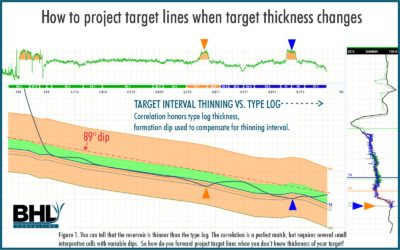This is the introduction to a blog series on “Positional Uncertainty” – not accurately knowing the position of your well path. What follows here is well studied and very well documented, but not so often discussed and sadly unknown among most geosteering practitioners.
Here is why it matters: absolutely all of our geosteering interpretation — formation structure and reservoir geometry — are built upon the position of the well path. If our positioning information is wrong… and it always is, at least a little… then our geologic interpretation is equally wrong. No exceptions!
Assuming an otherwise perfect geosteering interpretation, any error in wellbore TVD will be precisely replicated in formation TVD error. Similarly, any error in wellbore Inclination will be precisely and inversely reflected in formation Dip. If either or both of those are incorrect, any calculation of reservoir thickness is unavoidably wrong, at least a little. We’ll illustrate in future postings.
That has real-world consequences, including…
- Geosteering Interpretations that Violate (Pre-Drill and Post-Drill) geologic models
- Anomalous Formation TVD and Dip that just don’t fit the maps
- Inappropriate Pre-Drill Directional Plans for Subsequent Wells
- More Frequent Target Changes
- Increased Borehole Tortuosity
- Slower Drilling Time
- Lower In-Zone Percentage
- Intra-Team Problems
With something over 15 million aggregate feet and roughly 100 years of collective geosteering experience, BHL Consulting geologists have been forced to come to some understanding of these influences. We want to share some of what we’ve learned. So, we have compiled our “Top 10 List” of the sources of positional error. Our next post will present our Top 10 List, then we’ll dive deeper into some individual parts of the list.
Fortunately, there are some diagnostic and defensive tactics that geosteering interpreters can apply. We will also discuss those in future blog posts.As we proceed, please remember that:
- Wellbore positional uncertainty is always present in every horizontal well.
- Uncertainty increases as the lateral gets longer…it is statistically cumulative.
- Uncertainty does not necessarily equate to error, but it can. We should take “uncertainty” for exactly what it sounds like.
- Your survey data may have 1-3 figures to the right of the decimal, deceptively appearing more precise than it is. Remember the fundamental algebraic “Law of Significant Figures” – we cannot calculate to a level of precision greater than our least-precise input. For now, just don’t believe 2-decimal precision in your surveys.
- There are only three quantities in your survey report that were actually measured: Measured Depth, Inclination and Azimuth. Absolutely everything else is calculated from those.
- The calculations, themselves, introduce some level of uncertainty and imprecision.
- Any such errors are usually invisible in the survey reports, hence the term “Uncertainty”. But they will manifest themselves in the geosteering interpretation.
- Some of these influences can render TVD error into the 10’s of feet and Inclination error exceeding 2-3 degrees. Never mind unseen side-drift and doglegs.
- All these uncertainties can be hard to spot in ordinary survey data, but we will discuss are a few things to look for.
Remember that for Amelia Earhart, “close enough” wasn’t quite close enough. All things considered, directional surveys are usually remarkably accurate, just not as accurate as most geosteering interpreters believe. Knowing the limits of our data means knowing the limits of our work. Knowing the limits of our work means better targeting decisions. So, it’s time to actually recognize the uncertainty and plan accordingly.





0 Comments